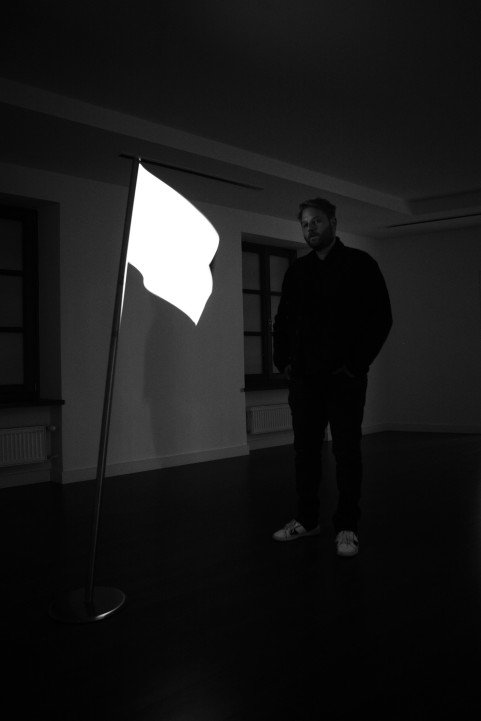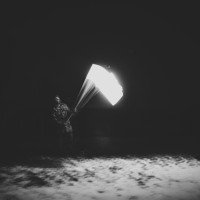FLAG
2012
MIXED MEDIA -
ELETROLUMINISCENT FOIL, EL- INVERTER, STAINLES STEEL
200 X 200 X10 CM
ED. OF 5
COUNTRESY THE ARTIST
Martin Sedlák | Eluminator
In 20th century art there is a long and rich history of the use of light, as a means of expression and a medium of ideas. We encounter on the way such radiant names as Zdeněk Pešánek, László Moholy-Nagy, Nicolas Schöffer, Bruce Nauman, Dan Flavin, James Turrell, and many others; among notable Slovaks one cannot fail to mention Milan Dobeš, that classic of kineticism. Martin Sedlák (b. 1978), an impressive representative of the younger generation of artists, responds to the art of light and movement in many ways in his work. Until recently he was often designated “one of the most promising talents” of contemporary Slovak art; this was confirmed by his winning the Essl Prize in 2005, several solo exhibitions, numerous international presentations, and representation in prestigious collections at home and abroad. One must emphasise, however, that in the course of the past decade he has managed to establish a programme which has all the marks of maturity and a ripe creative standpoint, aptly and very clearly formulated. Bearing witness to this are his many innovatory lighted paintings, objects, installations, and also graphic cycles, which he began to focus on after the year 2000 (Neonchair, 2000; Cursor, 2002; Look in to the Paradise, 2004; Nimbus, Emporio, 2007; Circulus, Gate, Canvas, Line 5, 2008; Splash, Interpolator, 2012 etc.). Not a few attempts have been made to categorise Martin Sedlák’s efforts as being close to the constructivist and minimalist tendencies working with the language of geometry, and lumino-kinetic art with its prefixes neo- and post-; however, he does not entirely fit into any of these classificatory pigeonholes. As a 21st century artist, he is naturally more radical and heretical vis-à-vis models and predecessors. With each new work or initiative he seeks to transpose, shift, change and reinterpret familiar historical forms and meanings (the aura, for example – spirituality linked with light); to fill his works with new, different life; to defamiliarise by detachment, overview, ironical commentary, and last but not least, by techniques and technological innovations.
In the Roman Fecik Gallery, having regard to its orientation hitherto (subtitled ‘Art for Collectors’) and the exhibition practice conducted in this space, he makes his appearance boldly and untraditionally, with one single work: the lumino-kinetic installation Flag (2013). In the darkness, before the visitor’s eyes, a luminous fluttering flag surfaces on a slender pole. The form and significance of the flag (or flags if you wish: precise vexillological definition plays no part in this), as sign and symbol, is meticulously prepared here, right to the very ‘marrow’ of the concept. Though the artist follows the traditional form, with demarcation of the shape that is the flag on the pole, he nevertheless abandons its traditional codification of meaning, the identifying signs (national, civic); he negates any symbolisation whatsoever (and with this the ideological or political overlap), the indication of belonging to a country, state, group... This ‘pure’ signal form, even if it is ‘symptomatic’, no longer requires an explanation. Here it is (as if) for itself alone, constantly in movement, following the dynamic loop of motion in a time interval, even as the ‘being’ and perception of the work are achieved via the category of light. But light, the illusion of non-materiality, is materialised by and through matter: using a luminous textile or electroluminescent foil. An essential point is that the artist is introducing an important technical innovation here. In fact, technology and its ‘embodiment’ in the work form a single integrated whole. Sedlák has cut out, as it were, carved out a form, by light from the darkness (from a black area, in the manner of graphic art), as if modulating the surface of the flag in an achromatic scale of tones (in the manner of painting), while at the same time seeming to create and determine the spatial placing, the inner and outer space of the work (in the manner of sculpture), even while an incessant change is occurring in time – surface being transformed to space, and vice versa. The artist moves freely and magnanimously on the frontiers of media and genres, overstepping the limits in the name of the most radical definition of the work: as object, with the lumino-spatial quality changing to lumino-dynamic. In this sense, Flag may be regarded as the most up-to-date personal and creative manifesto, and also a résumé of his work hitherto.
We may think of this exhibition of a single work by Martin Sedlák as a challenge, a gauntlet thrown down, for viewers (I believe they will find it an experience) and also for collectors. Has the time really arrived, in Slovakia too, to shift the familiar limits of appreciation of art works, and with them even the collecting of new media, towards more perceptive, more open and radical positions?
Katarína Bajcurová




